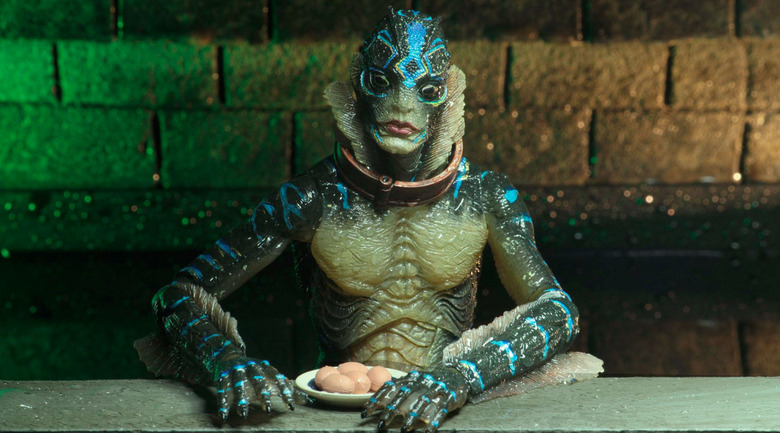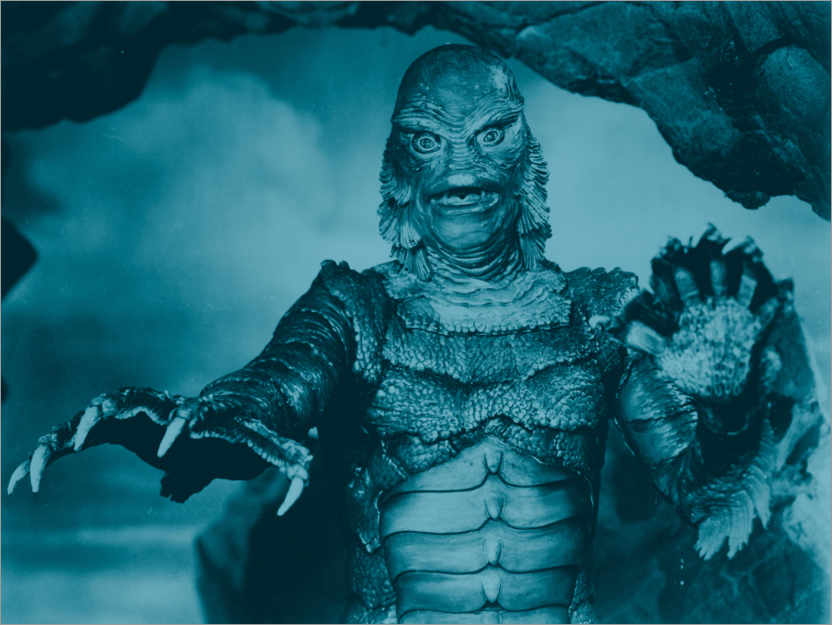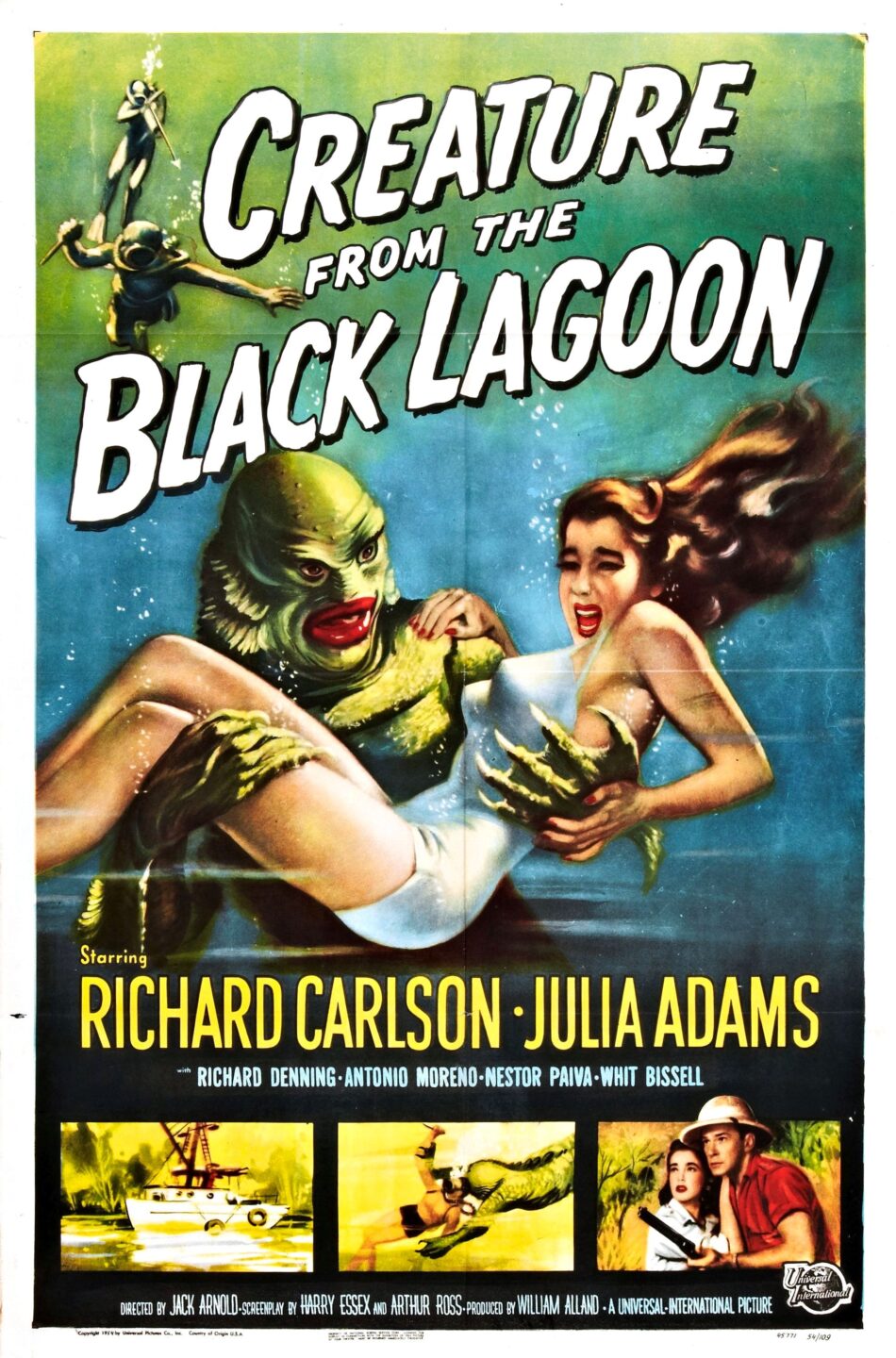
Setting:
The film is set in the year 1962, the background is the space race and the Cold War.
The story opens underwater, on a dream-like tracking shot through a fully submerged apartment building hallway. We see a kitchen table and chairs floating and then a woman sleeping feet above the couch, which is also floating.
The character of Giles introduces the story like a fairy tale (…a long time ago) setting the story of a princess without a voice on a small city on the coast. He tells us this will be a tale of love and loss, and “a monster who tried to destroy it all.”
The opening scenes present Elisa’s flat: it is a green-tinted apartment, with green bathroom tiles, green water in the tub. Her apartment hovers over a huge movie palace, and she lives amidst the echoes of the fantasy world below.
The colour green may symbolise the future. It is clearly said by Giles’s client who rejects his illustration because “Jello needs to be green, green is the future”). Moreover, Stricland’s new Cadillac is green, or better, teal (a dark greenish-blue colour) and the car seller repeats the same concept: being green the colour of the future and the man who drives that car being the man of the future.
Elisa works in a high-tech facility, there are long tunnels from where you can access several rooms that seem laboratories.
Characters
1- Elisa, the “princess without a voice” is a mute cleaner, who mops floors in the cavernous underground tunnels of a Baltimore-based corporation. She tends to follow the same routine every day: she wakes up, she has a bath, she boils some eggs and she cleans her shoes before setting off to work. Together with her friend Zelda she discovers the existence of the amphibian man in the laboratory. As she grows fonder of the creature, she tries to gain it’s trust and confidence as she finds in it something similar to her: a being that cannot speak, that does not judge her, and that she doesn’t judge. She was brought up in an orphanage as she had been found alone near a river.
2- Elisa’s counterpart in the film is Zelda, another cleaner who provides constant running commentary through the day, responding to Elisa’s sign language with a torrent of words. She is the funny character but also a close friend to Elisa.
3- Strickland is the security colonel who works at the company and is in charge of the creature. We learn that he found the amphibian man in the Amazon where it was worshipped as a God. He calls the creature “the asset” and he is very cruel. He always carries a cattle prod (which he calls an “Alabama howdee-do”). He lives with his family in a suburban home. He embodies a kind of bad-dream version of the mid-century American dream of a good job, a nice wife, a nice home and a nice car.
4- Something is being brought into a lab in the facility in a large steel and glass container filled with water: it is the creature, an amphibian humanoid which growls and howls. He is constantly tortured by Strickland. At the beginning of the story we may think he is the monster but then, we learn that he can understand Elisa’s language of signs, he loves listening to music and watching her dancing.
5- Giles is the first narrator of the story. He is the one who is telling the dreamy fairy tale of the princess without the voice. He is Elisa’s next-door neighbour; he was an illustrator once but he lost his job because of drinking, He is the third outcast of the film for his sexual orientation and alienation from the resto of the society.
6- Hoffstetler is the chief scientist assigned to work with the creature, and is the only figure in the government operation who believes the creature exhibits extraordinary signs of intelligence. We learn that Hoffstetler is actually a double agent and Soviet national named Dimitri, but his interests are driven by a genuine scientific curiosity, not any sort of political alignment. In his first conversation to his Soviet superiors, Hoffstetler stresses that he’s interested in the well-being of this odd, intelligent creature. He discovers that Elisa is able to communicate with the creature.
Analysing the sources:
The idea for the film came from Del Toro’s childhood, when he first saw the 1954 Universal horror movie The Creature From the Black Lagoon.
He picked up on the romantic tension between the monster and the leading lady, and wondered to himself what that movie might look like if the monster got the girl instead of getting killed.
Originally, Del Toro was in talks with Universal to remake that film, but ended up making a totally original work instead.
Del Toro decided to set the film in the early 1960s so that he could investigate major questions about American culture and mainstream society with enough distance to help the audience suspend its belief for the fantasy segments.
The result is a strange hybrid film: not just a cross between a monster movie and a love story, but also something dealing with bigotry and the acceptance of the “other” and the Cold War in the years between World War II and the Summer of Love.
The film ranges from a horror story to science fiction passing through social issues such as racism, diversity, and the figure of the outcast.
A connection to literature…
Frankenstein or the modern Promotheus by Mary Shelley.
This very famous novel was written by Mary Shelly in 1816-1817 during the Romantic Age. It is
classified as a gothic novel but it can be considered the first science-fiction novel too.
The Gothic novel developed in this period as a consequence of the Industrial revolution so the
Gothic symbols and characters can be seen as a denunciation of social problems.
This new type of literature gives a lot of importance to terror and horror and nature is described according to the new concept of the Sublime by Edmund Burke.
The setting evokes an atmosphere of fear and mystery and includes: isolated castles and abbeys, churchyards, dark places.
Frankenstein is a Swiss scientist who gives life to a creature using corpses and electricity. But the result of his work is a hideous being, a wretch that terrifies him and everyone who sees it. As a consequence, the creature is abandoned by his creator and he is rejected by the society. This results in a series of murders and killings as the monster wants to take his revenge on the human genre.
The creature should be the monster of the novel but is it really like that? Is he the true villain of the story? He is the outcast, the “other”, who struggles to be accepted by the society. He
experienced abandonment and rejection.
1) Working on the main topic:
“The loneliness of those born before their time, born different”
The Shape of Water” shows over and over again the demonizing of the “Other”: the heartlessness of denying living creatures dignity. This topic can be seen in the brutal treatment of the monster, the “voicelessness” of Elisa and in Giles, the lonely pre-Stonewall (famous riots in New York by some members of the gay community – 1969) gay man. They all come from “the future,” before their time. Discuss the quotation and give your personal comment on it.
2) Analysing the title: the shape of water.
Has water got a shape? Could you link this to the topic of the “Other”? Pay attention to the role of water as a symbol of the characters’ diversity.
3) Who is the villain of the story? Why?
Is the strange creature the real monster?
Before answering the question keep well in mind the voice-over at the beginning of the film: Giles said: “…this is the story of the princess without a voice and the monster who tried to destroy it all”.
Can you perceive any ambiguity in the “monster” mentioned there? Which features are typical of this character?
Now take into consideration the last scene: is it a new start, the opportunity for a new life in a new world, or does it remind of the beginning of the film and gives it a sense of circularity?




We think that the title of the movie is a metaphor which represents the fact that water takes many different shapes just like people.
One of the main topics of the movie is in fact the diversity between the characters.
Water is a liquid which is constantly moving and taking different shapes and, even if society tries to tell people which shapes they should fit in, a person is just like a drop of water and can try different shapes until they find the right one for them.
The water is a fundamental element in the movie, and it marks a circularity in the story and in Elisa’s life.
In the first scene Giles starts the narration as a fairytale and the ending closes the story in the same way but marking a new beginning in the protagonist’s life.
As the story progresses we learn that the real monster isn’t who we thought it was. The creature’s features make the audience automatically think that he is the villain, because that’s how monsters are often portrayed in society. However, the villain of the film doesn’t have a monstrous appearance, he is presented as a normal man. Infact, the actual monster is Mr. Strickland, who claims to be the new head of security in the facility where Elisa works. This shows how sometimes we tend to judge someone by their appearance and not by their actions. Mr. Strickland is a very violent man, who never shows any respect to anyone but himself. In contrast, the creature is docile until provoked and he constantly tries to help Elisa and Giles.
The last scene is portrayed as a new beginning for the characters, but it could also be connected to where it all started. From the scars on Elisa’s neck, to the opening scene of the film which shows many similarities to the ending.
“Seems like i was born both too early of too late for my life” is a reference that Giles, a gay man who isn’t free to express himself because of the society of the time, makes to the diversities that aren’t accepted during the period he lives in.
He isn’t the only one that suffers from this oppression: his neighbor Elisa, “the princess without a voice” who is mute and struggles to communicate with others, her coworker Zelda, a black woman who has to deal with her racist boss, and the creature that, because of his appearance, is an outcast of society, just as the others.
In modern society these differences are more accepted, but still not entirely welcomed due to the bigotry that still exists in human nature.
Gaia, Martina, Ludovica e Giulia.